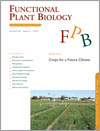
Functional Plant Biology
Volume 40 Number 2 2013
Crops for a Future Climate
FP12029Enhancing the chelation capacity of rice to maximise iron and zinc concentrations under elevated atmospheric carbon dioxide
Rising atmospheric carbon dioxide concentrations [CO2] will cause a multitude of physiological and nutritional changes to rice, one of the most important food crops in the world. Here I review these changes, focusing on the expected decreases in grain nutritional quality and identify stimulation of the Strategy II iron uptake pathway as a promising strategy to increase iron and zinc concentrations in rice grain under ambient and elevated [CO2]. These results may be applicable to other Strategy II crops such as maize, wheat and barley.
FP12056Optimal crop canopy architecture to maximise canopy photosynthetic CO2 uptake under elevated CO2 – a theoretical study using a mechanistic model of canopy photosynthesis
Crop yields are more related to canopy photosynthesis instead of leaf photosynthesis. This study established a mathematical model to link canopy architectural and biochemical parameters to total canopy CO2 uptake rate and explored the optimal canopy architectural parameters for elevated CO2 conditions. This new canopy photosynthesis model can help design crops to optimize canopy photosynthesis under different environments.
FP12056 Abstract | FP12056 Full Text | FP12056PDF (819 KB) | FP12056Supplementary Material (172 KB) Open Access Article
FP12162Pest and disease abundance and dynamics in wheat and oilseed rape as affected by elevated atmospheric CO2 concentrations
Future atmospheric carbon dioxide levels are likely to double in concentration, affecting agricultural crops, herbivorous insects and the possible progression of various plant diseases. The abundance of insects significantly changed under elevated CO2 in our study, whereas plant characteristics (phenology, aboveground biomass, foliar nitrogen and carbon contents) and development of fungal plant pathogens did not.
FP12044Minirhizotron imaging reveals that nodulation of field-grown soybean is enhanced by free-air CO2 enrichment only when combined with drought stress
Future food supply from legume crops, such as soybean, will depend on how rising atmospheric carbon dioxide concentrations and drought alter the formation of root nodules in which atmospheric nitrogen is captured. Soybean grown under drought and elevated carbon dioxide produced two to three times more nodules, but that nevertheless overall nitrogen capture by the plants decreased. This was caused by development of nodules in the driest soil layers, and indicates that soybean will be more negatively impacted by global environmental change than previously thought.
FP12357Rice cultivar responses to elevated CO2 at two free-air CO2 enrichment (FACE) sites in Japan
Opportunities exist for improving rice productivity under future CO2 concentrations. We examined intraspecific variation in yield responses to free-air CO2 enrichment (FACE) treatments at two sites in Japan, differing in growing-season mean air temperatures by 5°C. Yield enhancements due to elevated CO2 differed largely between cultivars ranging from 3 to 36%. A large sink is an effective trait for higher productivity under elevated CO2 at both sites.
FP12357 Abstract | FP12357 Full Text | FP12357PDF (509 KB) Open Access Article
FP12206Can elevated CO2 combined with high temperature ameliorate the effect of terminal drought in wheat?
Wheat may have different responses to future climates in Australia. Grain yield and biomass under elevated CO2 increased when the temperature was 2°C higher than the ambient, regardless of irrigation or terminal drought, but not when temperatures were >2°C higher than the ambient. The interaction of elevated CO2 × temperature × drought should be considered in the new generation of studies on crop adaptation to future climates in Australia.
FP12193Genotypic variability in the response to elevated CO2 of wheat lines differing in adaptive traits
Elevated CO2 increases wheat yields, but the variability in response suggests that some lines might respond better than others. We specifically chose lines that we know differ in various adaptive traits, some which might have limited the reponse to elevated CO2, and found that all lines responded in the same manner. This suggests that the current breeding effort for drought tolerance will not reduce the response to elevated CO2.
FP12057Intraspecific variation in growth and yield response to elevated CO2 in wheat depends on the differences of leaf mass per unit area
Optimisation of plant responses to increasing CO2 is a key strategy to achieve future food security. Identification of the leaf level traits that can capture the CO2 response will be easily adopted for the future wheat breeding programs. This work demonstrates the genetic capacity to adjust the leaf level traits, such as leaf mass per area and leaf nitrogen status to capture the CO2 response.
FP12179Drought adversely affects tuber development and nutritional quality of the staple crop cassava (Manihot esculenta Crantz)
Cassava is a staple for over 850 million people, but it is toxic unless properly processed. A monotonous cassava diet often coincides with outbreaks of diseases such as konzo, especially during droughts. The concentration of cyanogenic glucosides in young tubers was 4-fold higher when plants were water stressed, but was lower following re-watering. We conclude that any expansion of cassava into new areas must be accompanied by knowledge of appropriate methods for detoxification, especially in areas increasing in aridity due to climate change.
FP12130Impact of industrial-age climate change on the relationship between water uptake and tissue nitrogen in eucalypt seedlings
Seedlings of Eucalyptus saligna Sm. were grown under three CO2 concentrations (280, 400 or 640 μL L–1) and two air temperatures (current or current + 4°C). Total plant N uptake scaled with total water use and root biomass across all treatments, suggesting that reductions in tissue N concentration may be attributed to changes in root N uptake by mass flow due to altered transpiration rates.




